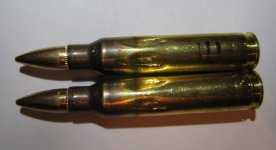So I had a really interesting experience at the range this morning, and it made me wonder if anyone here has ever experienced the same thing...
I was running a 14.5" Daniel Defense barrel with an AAC M4-2000 suppressor, H buffer, and Magpul P-Mag. About every third shot the carrier group would come forward and get jammed up about 1/2" from being completely into battery. After extracting the round, every time the case would be seriously dented and scratched from the bolt lugs digging into it.
At first I was thinking maybe the gun was over-gassed, or dirty. Then I switched to a Surefire-60 Magazine and the problem went away. Different P-mag, still ran like a champ.
Unsuppressed, the rifle runs great also- even with problem magazine #1.
Question is, could it really be that magazine causing the issue? It seems so weird that it's fine until I put the can on it, and then only that one particular mag jams things up. I've thought about trying an H2 buffer to slow the action down, but worry about losing reliability unsuppressed if I take that route. Or it's a common issue and I'm just reading waaay too far into this
I was running a 14.5" Daniel Defense barrel with an AAC M4-2000 suppressor, H buffer, and Magpul P-Mag. About every third shot the carrier group would come forward and get jammed up about 1/2" from being completely into battery. After extracting the round, every time the case would be seriously dented and scratched from the bolt lugs digging into it.
At first I was thinking maybe the gun was over-gassed, or dirty. Then I switched to a Surefire-60 Magazine and the problem went away. Different P-mag, still ran like a champ.
Unsuppressed, the rifle runs great also- even with problem magazine #1.
Question is, could it really be that magazine causing the issue? It seems so weird that it's fine until I put the can on it, and then only that one particular mag jams things up. I've thought about trying an H2 buffer to slow the action down, but worry about losing reliability unsuppressed if I take that route. Or it's a common issue and I'm just reading waaay too far into this

